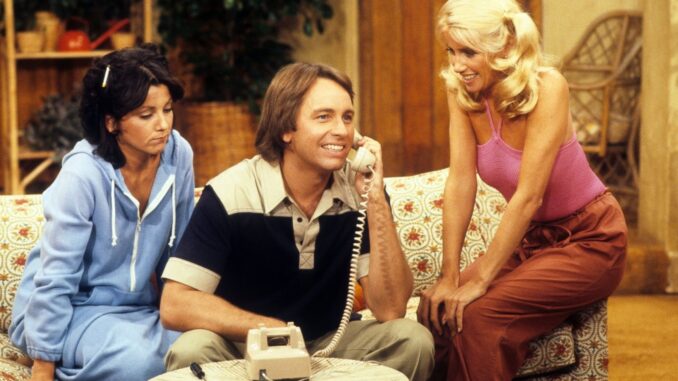
A Sitcom That Defined a Decade
In the golden age of television, Three’s Company emerged as more than just a comedy—it became a cultural touchstone. Premiering in 1977, the show mirrored the shifting dynamics of American society during a transformative era. But what made this sitcom stand out? Its humor was undeniable, but its portrayal of societal norms, gender roles, and cultural taboos made it a mirror reflecting the 1970s zeitgeist.
The Cultural Backdrop of the 1970s
A Decade of Social Revolution
The 1970s were marked by change—civil rights movements, feminist activism, and a newfound openness in discussing taboo topics. People were questioning long-standing norms, much like the characters in Three’s Company.
Television as a Social Commentary
Television in the ’70s evolved from escapism to a medium for reflecting societal shifts. Shows like Three’s Company embraced this change, blending comedy with subtle critiques of cultural norms.
The Premise of Three’s Company
A Revolutionary Living Arrangement
The plot was simple yet groundbreaking—a man sharing an apartment with two women. While innocent by today’s standards, this setup challenged traditional housing and gender norms of the era.
Humor Rooted in Misunderstanding
The humor often revolved around misunderstandings and mistaken identities, which cleverly highlighted societal hang-ups about sexuality and cohabitation.
Gender Roles on Screen
Breaking Stereotypes
Three’s Company tackled gender roles head-on. Janet and Chrissy, the female leads, were independent women navigating careers, relationships, and life, offering a stark contrast to traditional depictions of women as homemakers.
Jack Tripper’s Balancing Act
Jack, the male protagonist, had to pretend to be gay to justify living with two women—a comedic yet bold way to challenge stereotypes about masculinity and sexuality.
Addressing Sexuality with Humor
Subtle Yet Groundbreaking
While homosexuality was still a taboo subject on TV, Three’s Company addressed it through Jack’s character. The show used comedy to broach sensitive topics, encouraging audiences to rethink prejudices.
Normalizing Conversations
By introducing LGBTQ+ themes, even in a lighthearted manner, the sitcom paved the way for more inclusive narratives in television.
A Reflection of Economic Realities
The Rise of Roommates
The 1970s saw a surge in shared living arrangements due to economic constraints. Three’s Company mirrored this trend, making its premise relatable to viewers.
Financial Independence
The characters’ struggles with rent and jobs resonated with a generation seeking independence amid inflation and economic uncertainty.
The Role of Comedy in Social Change
Laughter as a Catalyst
Comedy has always been a tool for tackling serious issues. Three’s Company skillfully used humor to address controversial topics, making them approachable for mainstream audiences.
Challenging the Status Quo
The sitcom didn’t just entertain—it challenged viewers to reconsider societal norms, all while keeping them laughing.
Iconic Characters and Their Impact
The Relatable Trio
Jack, Janet, and Chrissy became household names, representing different facets of the 1970s American experience.
Supporting Cast with Depth
Characters like Mr. Roper added layers of humor and social critique, reflecting generational divides and prejudices.
Fashion and Aesthetic: The 1970s Look
Bell-Bottoms and Bold Colors
The show’s costume design was a perfect snapshot of 1970s fashion—vibrant, daring, and unapologetically expressive.
Setting the Scene
From the apartment’s decor to the characters’ wardrobes, every detail screamed 1970s, creating an authentic viewing experience.
The Legacy of Three’s Company
Breaking Barriers for Future Sitcoms
The show’s success opened doors for sitcoms to tackle bold themes, influencing a generation of television writers.
Nostalgia and Timelessness
Even decades later, Three’s Company remains a favorite, proving its humor and societal insights are timeless.
Conclusion: A Mirror to a Changing America
Three’s Company was more than just a sitcom; it was a cultural phenomenon. By blending humor with bold social commentary, it captured the essence of 1970s America—an era of change, experimentation, and breaking boundaries. It wasn’t just about three roommates; it was about a nation reimagining itself, one laugh at a time.
FAQs
1. Why was Three’s Company so controversial?
The show’s portrayal of cohabitation, gender roles, and sexuality challenged societal norms of the 1970s, sparking debates while entertaining audiences.
2. How did Three’s Company influence future television?
By addressing taboo topics with humor, it set the stage for more progressive and inclusive narratives in sitcoms.
3. What made the characters of Three’s Company so relatable?
Their struggles with relationships, finances, and societal expectations mirrored the real-life experiences of viewers in the 1970s.
4. Why does Three’s Company still resonate today?
Its timeless humor, coupled with its bold take on social issues, ensures its relevance across generations.
5. Where can I watch Three’s Company today?
The show is available on various streaming platforms, allowing new audiences to enjoy its classic charm and wit.
